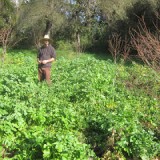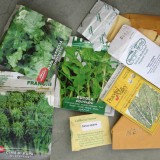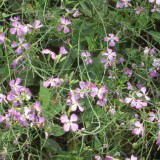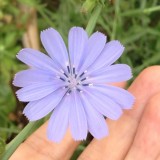
“I call it my Top Ramen garden,” says gardener, Root Simple neighbor and artist Anne Hars, “I planted things that go well in Top Ramen.” Hars is referring to her keyhole vegetable bed that she created this winter. With the keyhole, Hars has made good use of a very small front yard with a dense planting of Ramen friendly veggies including bok choi, three kinds of kale, sunflowers, carrots, peas, garlic, radishes, spinach, romaine lettuce, cilantro and parsley.

Anne with husband Bill and Petra the chihuahua.
She was inspired by a video by the British charity Send a Cow that shows the construction of a keyhole bed in Uganda. Keyhole beds are raised, circular vegetable gardens that contain a compost pile in the center. The compost pile provides nutrients and worm habitat. The keyhole form is said by permaulturalists to maximize space and ease of access.
Hars’ keyhole bed replaced two square raised beds that were made out of wood. “Gardens have to be rethought every couple of years and I feel less guilty then I did when I was using wood,” says Hars referring to the straw wattle she used to edge the keyhole. Straw wattle is a (mostly) biodegradable material made out of rice straw and plastic netting. You can find it at irrigation supply stores and on order at Home Depot. It comes in 25 foot lengths.
Soil for the bed came from the ground, from bagged soil that used to be in the wooden raised beds and from compost that Anne makes herself.

“I’m going to plant things under things,” says Hars. As the winter garden reaches maturity Hars plans on putting warm season crops in under the winter greens. “It will be a lazy summer garden.”
Ute, one Anne and Bill’s two chihuahuas, agrees.





Does “straw wattle” go by another name? I checked my Home Depot website and it has no clue what straw wattle is. When I searched on “straw” it showed me stuff like carpet, lampshades, floor tile, and deck restoration chemicals.
I like the idea of an alternative to wood, too. But the plastic netting, not so much. On the other hand, leaning against a round “wattle” would be easier on the hands and knees than against a 2-by plank.
Sorry, Kathy. Home Depot doesn’t carry it on the floor, and apparently, not on their website either, but you can special order it from them. Irrigation or landscaping supply places also It’s an erosion control device. Not something individual homeowner types usually buy. A good nursery might order it too.
The plastic netting is a drag, but at least it balls up really small–in terms of landfill, you know.
Try burlap. You might find some at a fabric store if you can’t find it at a garden supply.
I’m going to try this–if I can locate the straw wattle. However, any garden bed in my yard has to be protected by a fence–a strong fence–nothing wimpy–because my two big dogs love to dig and wallow in raised beds–and they will do anything to get into the beds.
Our friends used the burlap bags that coffee beans came in,they picked them up for free from a local coffee roaster.
We also planted a bed built from burlap a couple of summers ago.We used chicken wire for support because we were building a more cylinder shaped bed.It lasted until we decided to move that bed else where.
I was going to use Burlap and make my own wattle but Erik spotted wattle at a local home depot- they had ordered it by mistake. Home depot does sell roles of burlap but the coffee bags sound great.
I really liked the wattle because it is light weight and easy to work with. You can re-size it easily and re-use the plastic as bird netting, too. At east I am…
Thanks for the nice write up. One tiny correction. I’m not sure I was feeling Guilty about using wood- since I wasn’t using redwood. The hot sun baked my heavy clay soil into adobe bricks and created all sorts of soil issues. When I took my beds apart, it took me a week to
break up the soil! Kneeling on the side is very comfortable and I made the circle based on a comfortable arms reach to the center. I also used old sunflower stalks and wove bamboo and banana leaves trimmed from my tiny property to create a basket in the center.
I posit that the flexing of the wattle will help keep the soil around the edge from hardening, and the straw will help insulate against the strong SoCal sunshine. The slightly raised bed keeps out the skunks and makes gathering vegetables easier for Bill.
These are the Pros. I am sure I will be schooled in the Cons as I work with the form and the materials.
PS. I plan to repurpose the wood from the garden beds to build a bed headboard- maybe with some built in planters. I’ll keep you posted.
this principle of a ‘keyhole’ might help me reach some parts of my narrow garden better (its very small, as its in the city and along a wall). something to think about! and try out when the snow’s finally gone…
Do you mind if I link to this picture in my blog?
You’re very welcome to link to us!
Pingback: The Ramen Rater Noodle News #25 | THE RAMEN RATER
I am quite embarrassed to ask this what must be self-explanatory for other readers, but how does the wattle/burlap hold up the sides of the bed? In my mind, the cloth just flops over. I would love to try this if I could figure out how it works. Thanks!
Pingback: Keyhole Gardens – StumbleUpon | MrLaSecki WordPress